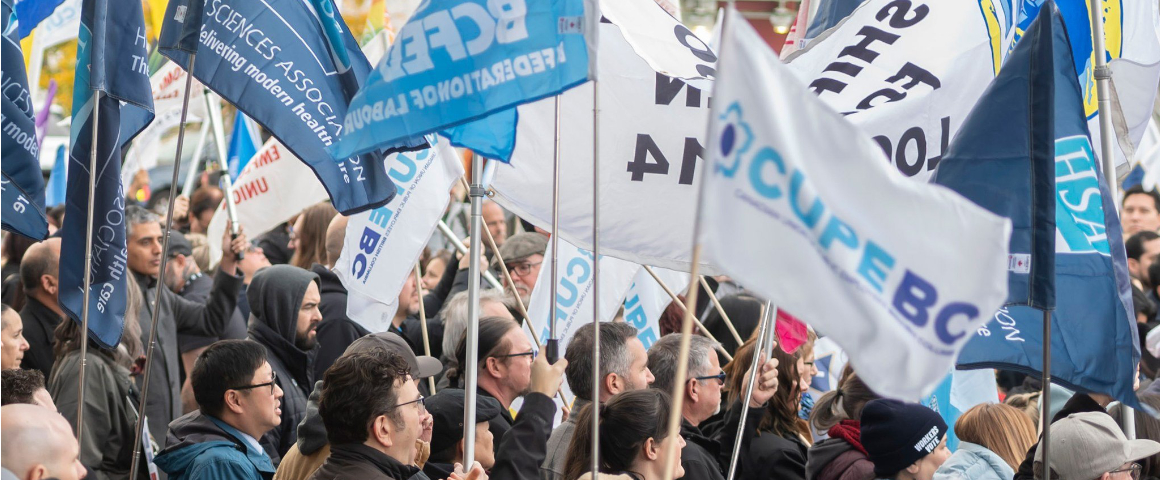BC Labour Bureau
In the early 1920s, while Canada’s working class was still buzzing from the victory of Bolshevism, the BC Federation of Labour’s newspaper published Lenin’s Left-wing Communism: An Infantile Disorder in a series of installments. Circulation of these issues reached 40,000 copies and were distributed across Western Canada.
This fact, taken from Tim Buck’s Canada and the Russian Revolution, seems that much more inconceivable after witnessing the BC Fed’s most recent convention, which took place in Vancouver from November 25-29.
Today, the BC Fed is firmly in bed with the NDP, as indicated by the time allotted to speakers from both the provincial and federal parties. BC’s labour minister, Jennifer Whiteside, boasted to delegates about the province’s $17.40 per hour minimum wage, ignoring that the Centre for Policy Alternatives calculates a living wage in BC to be between $20 and $27 an hour, depending on location. BC Premier David Eby proclaimed unions to be a “ticket to the middle-class,” an anti-worker sentiment that threatens to divide the labour movement by stimulating the misguided aspirations of some working people towards the petty bourgeoisie. Federal NDP leader Jagmeet Singh perhaps had the most vapid speech of them all, mostly recounting the time he made his brother pancakes (seriously).
The BC Fed Executive Council tightly controlled the convention agenda, allowing only minimal amount of time for debate. Over four and a half days, only 12 hours were allotted to 112 resolutions. Many resolutions that did hit the floor were edited to remove what were considered divisive issues and to defang any militant demand for action beyond lobbying governments and bosses. Particularly noticeable was the watering down of resolutions dealing with peace and international solidarity, including on the pressing issue of genocide in Gaza. Also notable was the resolution on increasing debate time for future conventions being left to the very end of the agenda, quashing any hopes of it being debated.
The resolutions that did hit the floor failed to match the urgency of the moment, sidestepping any real debate that could have addressed the realities of a crumbling education system, the drive towards healthcare privatization, the growing threat of nuclear war, the affordability crisis or environmental degradation. Instead, debates were confined to uncontroversial resolutions which passed with little disagreement from the floor.
Impatience with the neoliberal policies of the NDP, however, is becoming palpable. Despite the chair’s best efforts to suppress this dissatisfaction, delegates took their opportunities to call-out the Fed’s docility in the face of a tripartisan shift to the right. Several speakers challenged the rosy picture presented by the NDP leadership. The convention sent a strong message that more focus needs to be placed on policies that will provide jobs, living wages and protections for workers’ rights.
Most promising of all was the activity of the Action Caucus, which was established prior to the convention and grew throughout the week thanks to the distribution of leaflets and buttons, and by having delegates of the Action Caucus identify themselves as members before addressing the convention. After three days of requests, the chair even announced Action Caucus meetings on the final two days of convention.
The Action Caucus met daily at lunch and at adjournment to discuss important resolutions, coordinate tactics and discuss strategies for building a more militant labour movement. Action Caucus members were able to inject a good measure of class struggle issues into the debates. While the influence on the ultimate outcome of the final deliberations was limited, the Action Caucus nonetheless had a large impact in promoting the need for class struggle.
Many Action Caucus participants were attending their first convention, proof that more workers are becoming radicalized by the material conditions they face and are seeking to become politically organized. One of the main tasks now is to maintain this momentum, ensure Action Caucuses are convened at upcoming union conventions, and continue building the Action Caucus into a more experienced, larger and stronger force at the next BC Federation of Labour convention in 2026.
[Photo: BC Fed Facebook]
Support working-class media!
If you found this article useful, please consider donating to People’s Voice or purchasing a subscription so that you get every issue of Canada’s leading socialist publication delivered to your door or inbox!
For over 100 years, we have been 100% reader-supported, with no corporate or government funding.




